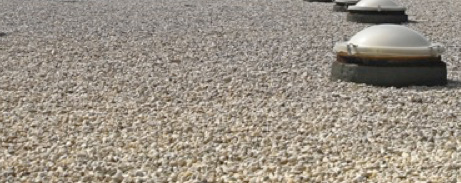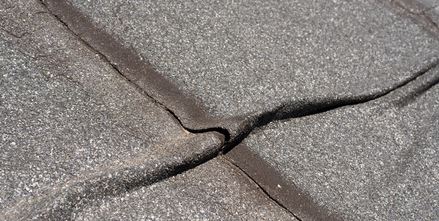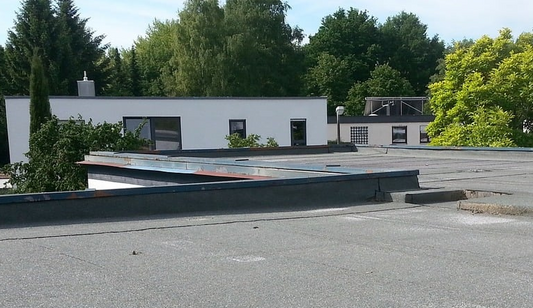Make it a habit to inspect your roof every year. Look for signs that could indicate trouble, such as areas that sag or spots that are lower than the rest of the roof. These can become water traps. If you spot such areas, fix them quickly by either leveling these spots or by installing roof crickets, which are designed to guide water towards drains.
Furthermore, it's beneficial to ensure your flat roof has a slight slope. This helps water flow off the roof, preventing it from pooling. By taking these steps, you not only preserve your roof's structure but also enhance its functionality.
Understanding and addressing these issues promptly can significantly extend the life of your roof and prevent costly repairs later on. For instance, a simple annual check can spot potential problems early, saving you from the hassle and expense of dealing with severe water damage.
By maintaining a proactive approach to roof maintenance, you ensure your building stays protected and functional.
Key Points
- To prevent water from pooling on a flat roof, which can lead to damage over time, it's essential to keep the drainage systems clean. Regularly clearing out drains and gutters ensures they can effectively channel water away from the roof. Each year, it's wise to inspect the roof for any areas that might be dipping or sagging. These inspections help catch potential problems early, preventing bigger issues.
- One effective solution is to install tapered insulation. This method involves placing insulation in a way that creates a gentle slope, guiding water towards the drains. This simple adjustment can greatly enhance water runoff and reduce pooling.
- If the roof membrane or underlying areas are damaged, it's important to either repair or replace them promptly. Damaged areas can worsen water accumulation, leading to more extensive roof issues.
- In places where water tends to collect more frequently, consider adding roof crickets or extra drainage paths. Roof crickets are small, peaked constructions that help direct water to drains, especially around higher structures like chimneys or vent pipes, ensuring smoother water flow off the roof.
- By adopting these measures, you can significantly extend the life of your roof and prevent the complications associated with water ponding.
Understanding Flat Roof Ponding

When water pools on a flat roof for more than 48 hours, this is known as flat roof ponding. This usually happens because of inadequate drainage or a design flaw in the roof that prevents water from draining properly. Over time, this can be a serious issue, as the standing water can erode the roofing materials, which may result in leaks and could threaten the building's structural integrity.
Why does water accumulate on some flat roofs? In many cases, it's due to poor roof design or blocked drainage systems. Additionally, as buildings age, they may settle slightly, causing depressions on the roof where water can collect.
It's crucial to address ponding issues early to avoid extensive damage and expensive repairs. By recognizing the underlying causes and understanding the potential damage, building owners can take proactive steps to ensure their roof remains effective at protecting the structure beneath.
For example, regular inspections can help identify areas where water tends to collect, and maintenance teams can clear blockages in drainage paths. These simple actions can greatly extend the life of a roof and safeguard the building.
Regular Drain Maintenance
To avoid water buildup on your roof, it's essential to regularly clean the drains.Leaves and other debris can clog them, particularly after storms or in the autumn, obstructing the flow of water. This can cause the water to pool, adding extra weight and potentially damaging your roof structure.
Keeping the drains clear helps the entire roof function better. When drains are blocked, water accumulates, and this can weaken the roof membrane, leading to leaks and expensive repairs.
Instead of doing it yourself, consider hiring professionals for drain cleaning. They can effectively clear hard-to-reach blockages and identify problems early, preventing major issues.
Annual Roof Inspection
Scheduling a yearly roof inspection is a proactive step to identify potential issues, such as ponding, before they become serious problems. By examining the roof's condition regularly, you can maintain its integrity and functionality. During these checks, experts look for drainage problems or design issues that might cause water to gather. The goal isn't only to discover these problems but also to prevent them.These inspections are crucial because they can uncover subtle signs of wear or damage that are often missed without professional expertise. They evaluate the roof's overall health, identifying areas that might cause future issues. Catching these problems early is essential as it allows you to fix small issues before they escalate into expensive repairs.
Regular assessments also give you a chance to confirm that past maintenance work is effective and make adjustments if needed. This continuous monitoring ensures that solutions for managing water flow, like proper drainage, are still working. By making roof inspections an annual habit, you're not only looking after your roof but also protecting your building from potential structural damage due to unchecked water accumulation. It's always better to address these issues promptly rather than facing the consequences of neglect later.
Addressing Roof Low Spots
Addressing low spots on your roof is crucial to prevent water from pooling, which can lead to leaks and weaken the structure over time. Ensuring good drainage is key to managing this issue.Start by regularly cleaning your roof drains. It's a simple task that's often overlooked, yet leaves, twigs, and other debris can clog these drains, causing water to gather in the low spots. Keeping these drains clear ensures that water can flow away from your roof effectively.
If cleaning the drains doesn't solve the problem, consider installing additional drain lines. Professional roofers can evaluate your roof and install extra drainage where needed to improve water flow and prevent accumulation. This proactive step helps direct water away from problematic areas, integrating seamlessly with your current drainage system.
Acting before damage becomes visible is important. By filling in low spots and upgrading your drainage, you can prevent future issues. This not only saves money but also extends the life of your roof. Regular maintenance and strategic improvements can greatly enhance the overall health of your roof.
Ensuring Adequate Roof Pitch
Ensuring your flat roof has an adequate pitch is crucial for effective water drainage and to prevent water pooling. Contrary to what the term 'flat roof' suggests, these roofs require a slight incline to direct water towards drainage points. Without this incline, water can accumulate, potentially causing structural issues over time.For flat roofs, it's advisable to have a minimum pitch of 1:40. This gentle slope efficiently channels water away, safeguarding the roof's structure. When constructing a new building or renovating an existing roof, it's essential to incorporate this slope from the start. This proactive approach helps avoid the need for future corrections and extends the roof's lifespan.
If you're planning a new construction or a major roof renovation, consider the roof pitch early in the process. By doing so, you ensure that water flows properly, reducing the risk of damage and prolonging the durability of the roof.
Maintaining a proper roof pitch not only prevents immediate issues like water pooling but also contributes to the long-term health of your roof.
Installation of Roof Crickets
When installing a roof, especially a flat one, it's crucial to consider the role of roof crickets in managing water flow. These structures, shaped like triangles or pyramids, are placed above obstructions such as chimneys and vents. They help by directing water away from these areas, preventing it from accumulating and causing damage.Installing roof crickets isn't just a good practice; it's essential for the effective functioning of your roof's drainage system. They guide water to designated drainage areas, minimizing the risk of water pooling, which can weaken your roof over time. This proactive approach enhances the durability of your roof and protects the structural integrity of your building.
Incorporating roof crickets can significantly improve the health of your flat roof by preventing water buildup, a common cause of major roofing problems.
Importance of Roof Membrane
To ensure your building is well-protected, it's crucial that the flat roof membrane remains unbroken, serving as a shield against water and subsequent damage. If the membrane is damaged, it can cause leaks and structural issues, leading to expensive repairs. The roof membrane is more than just a cover; it plays a critical role in protecting the whole structure from the top.Here are three important reasons to keep your roof membrane in good condition:
1. Blocks Water Entry: The main function of the roof membrane is to prevent water from entering. Even minor damage can allow water to seep in, leading to problems like mold, decay, and the weakening of building materials. Regular checks and timely repairs can fix small issues before they escalate.
2. Promotes Durability: Keeping your roof membrane in good shape helps prolong the life of your roof. Modern membranes are built to withstand environmental factors such as UV rays and temperature fluctuations. Continuous care ensures they function well for a longer period.
3. Lowers Repair Expenses: Maintaining your roof membrane helps avoid major water damage, reducing the likelihood of costly repairs. Regular upkeep is a worthwhile investment that leads to a more dependable roof with a longer lifespan.
Preventing Clogged Drains & Gutters
Regularly cleaning your drains helps to remove debris and prevent clogs that could cause significant issues on your flat roof. Keeping these drains clear is crucial to prevent water from pooling, which over time can weaken the structure of your building. Consider scheduling professional roofing services each year to manage this maintenance, as it can prevent more severe problems in the future.Accumulated debris, including leaves and dirt, is a primary reason for water pooling on flat roofs. If you don't clean your drains regularly, these materials can block your drainage system, leading to water accumulation. This excess water can strain your roof membrane and might result in leaks or structural damage.
Maintaining clean drains is essential not just for removing visible blockages but also for the overall health of your roof. Well-maintained drains reduce the risk of significant damage and extend the life of your roof. Being proactive about drain maintenance can help you avoid expensive repairs and ensure that your roof functions well for many years.
Effective Water Drainage Strategies
Proper roof drainage is crucial for maintaining the structural integrity of a building and preventing water damage. Here's an easy guide to ensuring your flat roof drains effectively:1. Install Tapered Insulation: Adding tapered insulation boards helps create an adequate slope on your roof, directing water towards drainage points. This is beneficial for both new and existing roofs as it prevents water from pooling, which can lead to leaks and structural damage.
2. Use Adequate Drainage Outlets: It's important to have the right number of drainage outlets for your flat roof based on your roof's design and size. Options like internal drains, gutters, and balcony outlets are essential for quickly removing water from the roof, thus preventing overflow and potential damage.
3. Adhere to with Building Regulations: Following local building regulations for drainage isn't only a legal requirement but also crucial for your roof's longevity and safety. These regulations are designed to ensure that all structural elements, including drainage systems, are safe and effective.
Long-Term Roof Care Tips
To ensure the long-term health of your flat roof, it's crucial to conduct periodic inspections and address any issues swiftly, especially concerning water ponding or poor drainage.Effective drainage systems are essential to avoid water buildup, which can cause structural damage over time. Keep drains and gutters free from debris such as leaves, which can block the water's escape route.
It's important to fix any dips or sagging areas on your roof as soon as you spot them. These areas can collect water and lead to ponding, weakening your roof's structure. Hiring a professional to evaluate and repair these issues can be a practical approach.
Consider installing roof crickets if you've noticed water pooling near chimneys or large vent pipes. These peaked constructions help divert water away, ensuring it flows smoothly off your roof during rainstorms.
Lastly, ensure your roof is slightly sloped towards drains or gutters to improve water runoff and prevent water from pooling. This simple adjustment can significantly enhance the effectiveness of your roof's drainage system and extend its lifespan.
Wrapping up
To effectively prevent ponding on your flat roof, it's crucial to take a proactive approach. Regularly clear your drains to ensure water can flow freely and conduct an annual inspection of the roof to spot any potential issues early. Address any low spots as they emerge too prevent water accumulation.Remember, good water management is crucial for keeping your building dry and secure. By following these steps, you'll enhance the longevity of your roof and protect your investment.




